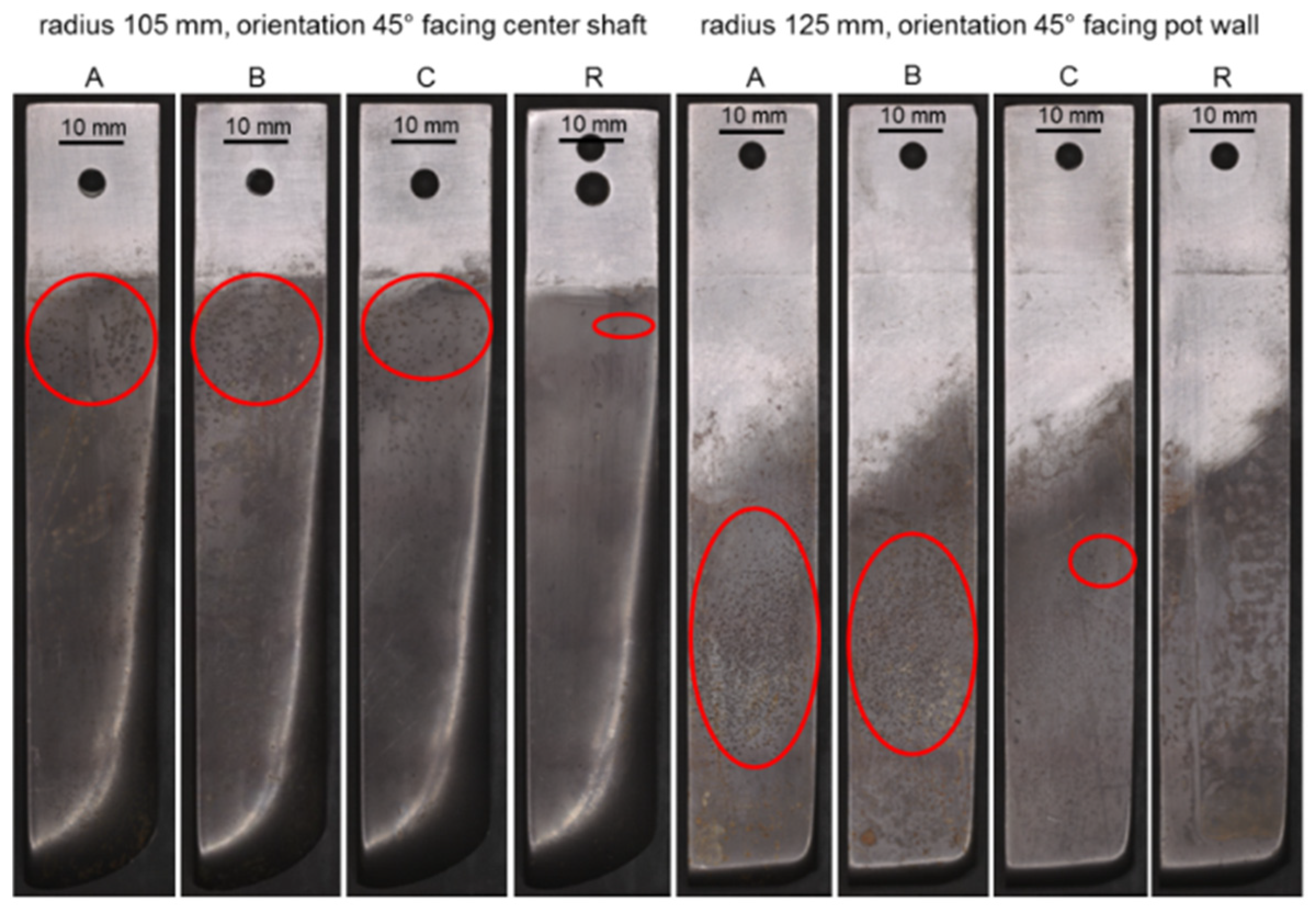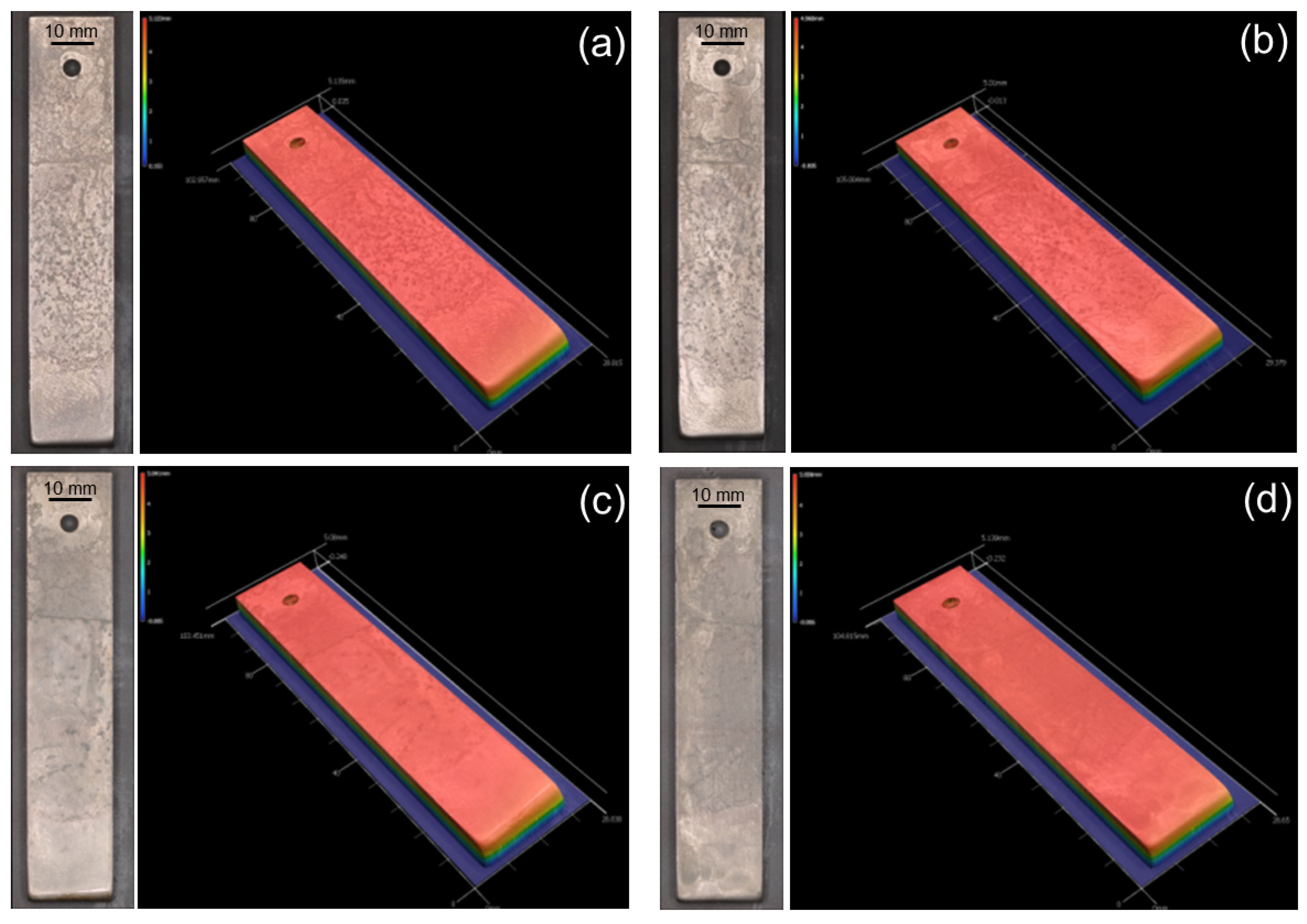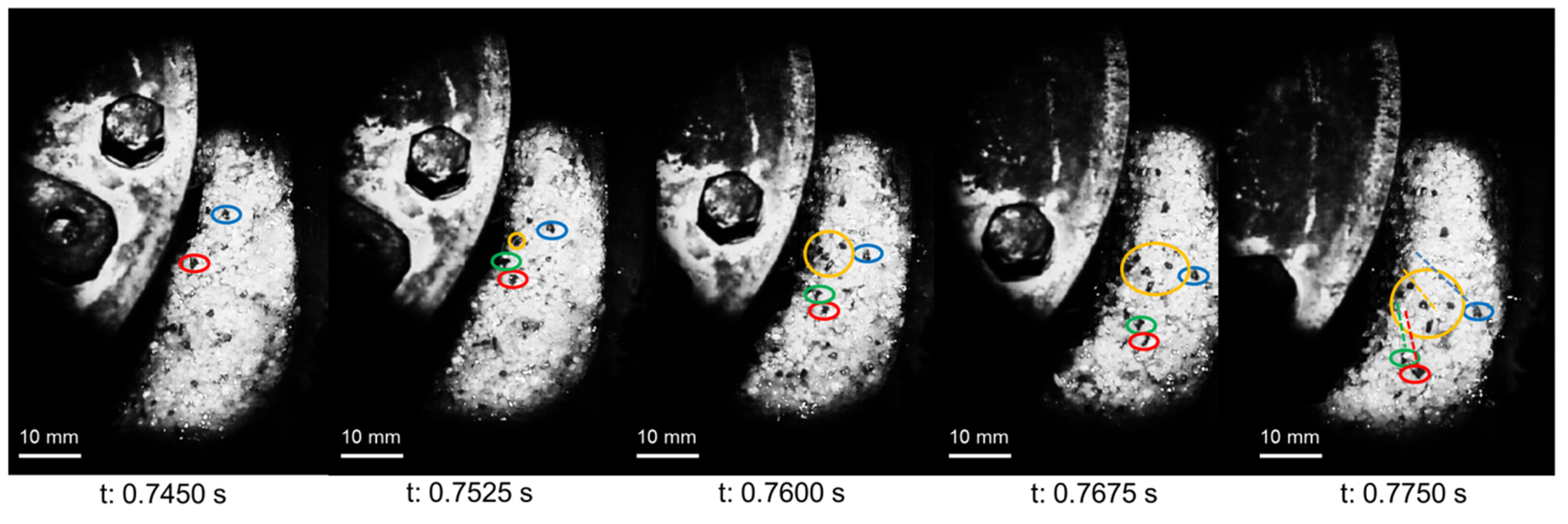3.1. Average Relative Mass Loss
Material loss due to wearing activities was detected for all of the investigated materials (A, B, C, and R) with the effect of different sliding distances and sample radii. The absolute mass change in the function of the sliding distance of the tested slurry pot specimen in testing Phase 1 is shown in
Figure 4. In this experiment, the different sliding distances are a consequence of the radial placement of samples. In
Figure 4, all results are shown for all materials (A, B, C and R) for all radii (65, 85, 105, 125 mm), indicating the orientation of the specimen. As previously described in the test methodology, orientation “O” refers to specimens oriented towards the outside (pot wall) while their surfaces are aligned 45° with the particle flow. Orientation “I” refers to specimens oriented towards the inside (centre shaft or centre of rotation) while their surfaces are aligned 45° with the particle flow.
The mass decreased linearly in the function of sliding distance and specimen placement in the case of all specimens. Samples mounted on a radius of 105 mm resulted in a severe mass loss in the case of all tested materials, as can be seen in
Figure 4. This high mass loss on a radius of 105 mm was unexpected as the wear severity is supposed to increase with higher speed operation [
13]. The second most severe wear was observed on the specimen mounted on a radius of 65 mm. Even though all of the specimens were aligned 45° to the abrasive particle flow, their orientation had a more significant effect on the wear of these materials. The slurry pot samples mounted to face the centre shaft (centre of rotation), namely on radii 65 and 105 mm, suffered more severe wear. Hence, the effect of specimen orientation (angle of attack) had a more significant role in the wear severity than the difference in the radius (higher testing speed). The severe wear on the specimen oriented towards the centre shaft could be explained by the effect of the centrifugal force on the slurry. The centrifugal force pushes the abrasive particles in a radial direction to the inside-oriented specimen surfaces, resulting in more severe material removal [
14].
Table 4 shows the average relative mass loss [%/100 km] of the examined slurry pot specimen (material A, B, C, R) on all radii (measured throughout each 20-h cycle) and orientation. The relative mass loss was calculated using the contact area and was normalised with the sliding distance.
From
Table 4, it is confirmed that material B performs best among the tested materials. It overperforms the rest of the materials by having ~0.5–1% reduced mass loss on 100 km on average. It is clear from the data that the standard deviation values are higher in the case of the radius 85- and 65-mm tests. In these cases, the small amount of overall material loss (1–1.8%) is the explanation for the higher standard deviation. The uncertainties involved in the wear test evaluation on radii 65 and 85 mm prevent a precise comparison. In these cases, it is challenging to measure the small amount of wear after each cycle due to the noise of the removed rust layer. Therefore, conclusions from the wear data will be drawn only from radiuses of 125 and 105 mm, where the standard deviation is below 10%. Also, in the case of radius 105 mm samples, the wear severity is an order of magnitude higher.
Table 5 shows the material ranking based on these conclusions.
It is important to note that the average mass loss of specimens mounted on radius 65 was around three times higher compared to the mass loss of samples mounted on radius 85 mm, although the former was running at a lower speed. As previously stated, specimen orientation has the greatest influence on wear in this test configuration. Specimens facing the centre of rotation (centre shaft) were observed to wear more as the centrifugal force pushed the abrasive media particles closer to their surfaces. The two most promising materials (materials A and B) were further investigated in phase two. Here, the focus of the tests was on specimen orientation and its effect on the wear mechanism and wear severity. In test phase two, the severe material loss at a radius of 105 mm was confirmed (
Figure 5). This phenomenon could be explained by the media circulation and the effect of the centrifugal force in this unique set-up. The specimen orientation (inwards centre shaft/outwards pot wall) influenced the wear rate in all of the specimens studied in phase two in the same manner as that performed in the first phase. Furthermore, the severity of wear was related to the specimen’s orientation to the media flow. The wear severity of specimens with radii of 65, 85, and 125 mm was ranked as follows: 30° < 60° < 45°. In this case, the lowest wear corresponded to a specimen oriented 30° to the medium flow, whereas the greatest corresponded to 45°. However, in the instance of a radius of 105 mm, the alignment sequence was 60° < 45° < 30° as wear severity increased. Similarly to the previous phase, samples placed on a radius of 105 mm wear away an order of magnitude faster. On the top zone of these samples, a small degree of pitting was also seen (radius 105 mm). When the wear processes of these samples (radius 105 mm) were analysed, it was shown that abrasion was prevalent. This abrasive process was linked to a polishing action of the contact surface with occasional scratches near the rounded specimen edges. During turbulent flow, the media is pressured on the specimen surface due to centrifugal force. Because of the structure of the specimen holding system, specimens orientated towards the centre of rotation (radius of 65 and 105 mm) are more vulnerable to this abrasive impact. However, on samples with a radius of 65 mm, the force and velocity are insufficient to generate the same result.
3.2. Damage Analysis via Surface Topography
The identified wear mechanisms from the post-mortem analysis (
Figure 6) validate the explanation of wear severity.
Figure 6 shows the images of the tested specimens from material A after the first cycle (a, b, c, d) and their corresponding height map. Abrasion was observed mostly on samples mounted on a radius of 105 mm, and pitting was observed to be the most severe on samples mounted on a radius of 125 mm. The significant pitting present on samples mounted on a radius of 125 mm could be explained by the particle movement in the media. These particles were found to bounce back from the pot wall after the impact. Severe pits appeared on the specimen surface area close to or above the media level, where the contact was an impact rather than sliding. Here, the damping effect of the water was less significant. After the impact, the backflow effect of the abrasive particles (media equilibrium) within the water was prevalent. In order to validate this explanation, high-speed camera video recordings gave an insight into this phenomenon.
In
Figure 6, the red circles indicate the areas observed to be exposed to severe pitting. As concluded, the specimen oriented towards the pot wall suffered severe pitting but less overall wear. This was observed in the case of all of the tested materials.
Figure 7 shows an image comparison of worn slurry pot specimens after 180 h of operation for all materials with a radius of 105 and 125 mm, as these samples had the largest worn areas. By comparing the images, it is clear that material C did not experience as much pitting. This could be explained by its more ductile behaviour, which originates from its microstructure.
Its lower hardness helps to minimise the pitting formation that results from the subsurface cracks caused by the impacting particles. The geometry changed according to the position of the specimen, with edge rounding and a shortening of the total length. Due to the custom design configuration of the slurry pot tester, both pitting and abrasion co-existed. The observed characteristic features were dependent on the zone of the specimen. The contact area between the specimen surface and the abrasive media increases with the specimen radius. This increase comes from the effect of the centrifugal force on the slurry, excluding samples mounted on a radius of 125 mm, where the abrasive particle movement has a different characteristic close to the pot wall. The observed characteristic wear mechanism features were dependent on the specimen zones. Two zones could be separated for each wear sample. On the bottom part of the specimen, at the underwater level, where it is inside the abrasive media during operation, a polishing effect and severe material loss were observed. Furthermore, close to the rounded edges, small abrasion scars were noticed. Whereas in the upper zone of the specimen, where the contact is close to the surface level of the abrasive media, pitting was present. Pitting was found to be dominant in the upper part of the worn zone, which is in the lower pressure zone of the media. Pitting was present in the upper part of the worn zone in the case of all specimens and materials. However, the material composition, the radius of the pitting zone, and the orientation of the specimen all played a role in the severity of the pitting zones.
In Phase 2, the best (Material B) and worst-performing materials (Material C) from the first cycle (1 × 20 h) were compared (
Figure 8). The 3D geometry images are extracted from the specimens placed on a radius of 65 mm, oriented towards the centre shaft. Materials are characterised as ductile or brittle in erosion literature based on the dependency of their erosion rate on the angle of impingement [
15]. The highest erosion rate of ductile materials is at low angles (15–30°), while the maximum erosion rate of brittle materials is close to 90° [
16]. Except for material C, which has a microstructure and a lower hardness, the tested materials are deemed more brittle than ductile. It was observed from the first phase results that the pitting on the surface of the material C specimen was not significant. As the specimen angle with the media flow was increased to 60°, this effect of polishing and abrasion was found to be less dominant. Hence, the observed pitting zone increased with the increased attack angle resulting in a less abraded worn area. The wear rate data shown in
Figure 5 validates this explanation. The pitting phenomenon was further investigated. The depth of the pits is connected to the impact speed of the particles.
Figure 9 shows the comparison of the pits from radii 85 and 125 mm with their 3D and height maps.
The samples mounted on radii 85 and 125 mm are oriented towards the pot wall and experienced the most significant pitting. The two most brittle materials from this investigation were compared (materials A and B). From
Figure 9, it is clear that pits were found to be deeper on the specimen surfaces, which were mounted on a radius of 125 mm. The more severe pitting on the samples mounted on a radius of 125 mm could be explained by the theoretical 0.6 m/s difference in sliding speed and the more severe effect of the abrasive media due to the centrifugal force. This observation is in line with the study of Shitole [
17] regarding the effect of impacting particle kinetic energy on slurry erosive wear. The pitting was found to be more significant with the sliding distance (
Figure 10).
Pitting was observed to be a result of not a single but repeated cyclic deformation. The number and size of the pits grew as a function of the operation time. The investigation of the pit crater bottom surface showed the presence of micro-cracks and an uneven material surface. Examples of these pit surfaces are shown in
Figure 11. According to the Hertz contact theory [
18], the highest stress in the material is below the contact surface by a few hundred m. Due to the dynamic loading, plastic deformation of the material occurs with dislocation formation, leading to the spread of micro-cracks beneath the surface. These could merge and reach the surface, resulting in a crater. The uneven, not polished surface with signs of micro-cracks in this crater/pit verifies the described formation process. These features (highlighted with red circles) could be identified on high-magnification images taken from the bottom surface of the pits. The higher impact (kinetic) energy on a radius of 125 mm resulted in larger pits than on a radius of 85 mm. The growth and spread of this phenomenon increase at the top part of the worn zone as the sliding distance increases. Hence, the pits are not a result of a single-cycle deformation, and the material is not removed through a single impact.
3.3. Damage Analysis via High-Speed Camera Recordings
Images from the high-speed camera recordings highlighting the movement of the tracked abrasive particles are shown in
Figure 12. To be able to track individual particle movements, some corundum particles were painted for high-speed camera recording. This contrast enables the software to keep track of the individual particle movement. After the given reference input, the software calculates the velocity vector for the given points or particles. This verified the surface speed and highlighted that the movement trajectory at the top part of the specimen often resulted in impacts with the abrasives. The recordings confirmed the post-mortem identified wear mechanisms observed on the slurry pot specimen. These contact conditions and impacts observed at the surface level of the media flow verified the findings of the pitting phenomenon.
Figure 12 shows the particle trajectory after the impact for different periods. The calculated average speed vector from coordinate points in the i-Speed software ranged between 1.123–1.637 [m/s]. This range is explained by the not uniform initial conditions of the impact (e.g., change in the presence of water, initial position/orientation difference of the corundum particle). The estimated mass range of a corundum particle is between 0.0116–0.0194 [g]. This resembles to an impulse (I = m × v) range of 0.0131 × 10
3–0.0317 × 10
3 [kg m/s], meaning an individual corundum particle kinetic energy range of 0.0073 × 10
−3–0.0259 × 10
−3 [J]. This is not sufficient for a single impact to cause such severe material damage and form pits as the water further damps the impact. According to Palmgren and Miner, failure occurs when the cumulative damage caused by each loading cycle equals one. The general form of the Palmgren-Miner rule [
19] is given by:
where k is the number of stress levels in the block loading spectrum, n
i is the number of cycles at each stress level in the block loading spectrum, and N
i is the number of cycles to failure at each stress level. The fatigue calculations are only an estimate, and the calculated lifetimes are very sensitive to small changes in geometry that affect stress levels. Also, the damping effect of the water, which is hard to estimate, plays a significant role. In practice, the stress change over time is, in general, stochastic and not harmonious. The summed low energy impacts are capable of fatigue crack initiation, leading to pitting formation, even before 20 h of operation, as shown in
Figure 11. From the initial material properties, material C and reference material R were expected to perform better against impact as their less brittle characteristics originate from the microstructure and lower hardness [
20]. This was verified in the observations about the pitting.
3.4. Hardness and Surface Roughness
The change in the surface topography and hardness of the tested specimens were also investigated. All materials were found to have a polished abraded zone at the bottom of the samples with traces of abrasion scars. Material loss in this area was found to be more severe, with visible changes in the geometry in the form of reduced length and blunted or rounded edges. On the top of the worn zone for each material, pitting was observed. Its severity depended on the specimen orientation and the material microstructure. Before testing, the surface roughness parameters of all specimens were similar due to the same manufacturing process: Ra~0.3 µm (arithmetic mean height), Rz~2.2 µm (maximum height), Rq~0.4 µm (root-mean-square roughness). After testing, surface roughness values are shown in
Table 6 for both identified worn regions (abraded and fatigued areas). In the case of all materials, the surface of the contact area smoothened and experienced a polishing effect. Moreover, specimen orientation did not affect the resulting surface roughness of the distinguished wear zone.
On average, the surface roughness of the polished zone was reduced to Ra~0.1 µm and Rz to ~0.8 µm within 20 h of testing. The standard deviation of the roughness measurements was below 30%. The top worn zone of the specimen, where pitting was identified, experienced roughening of the surface to Ra~0.8 µm, Rz~7.5 µm. The polishing was present in parallel with the hardening of the contact surface.
Figure 13 shows the hardness change of all tested materials as a function of the operating time. The hardness distribution in the worn zone was constant. This means the sample depth in the slurry did not have a significant effect on the hardening. The hardness gain was already present after the first 20 h of testing. The two hardest and best-performing materials (materials A and B) experienced an average +15 HV hardness gain. The observed pitting was also the most severe in the case of these materials. Material C and material R experienced only minor hardening. The pitting observed on these materials was less significant as well. Material C did not have such a pronounced hardening effect.



















